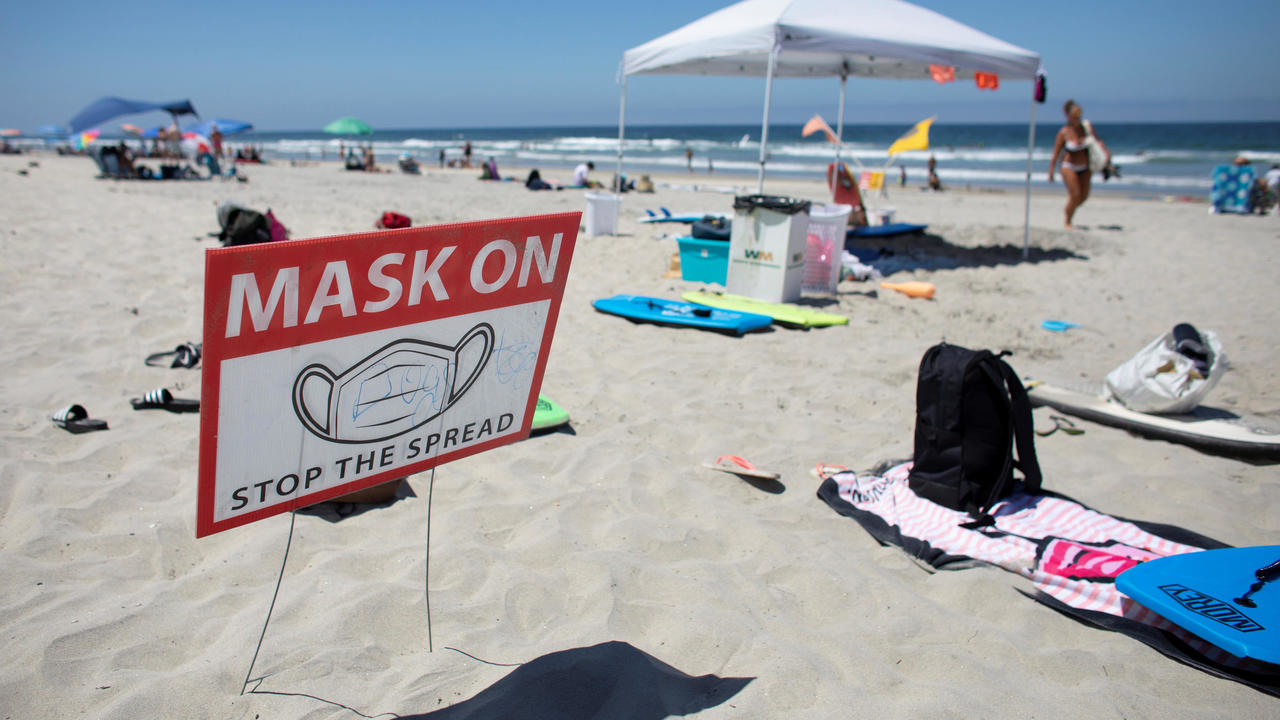
This article is more than
5 year old
In a drastic U-turn, California Governor Gavin Newsom re-imposed a lockdown on July 12 after the state recorded around 16,000 new cases over the previous weekend.
For the second time since Covid-19 took the world by storm, restaurants, bars, cinemas, museums and zoos closed across the Golden State. Churches, gyms and hairdressers shut in the 30 worst-affected counties. In two especially hard-hit urban areas – Los Angeles County, the most populous in the US, and San Diego County – the school year will start in August with online classes.
This constitutes an embarrassing reversal for California, the largest US state by population and the world’s biggest sub-national economy. While the coronavirus tore through the tri-state area – especially New York City – in the spring, California was regarded as a great success story in holding the disease back.
‘We flattened the curve’
One of the most internationally connected American states, California had its first recorded case – and the third in the country – on January 26. It then hosted the first known instance of community transition on American soil on February 26 in Solano County, a suburban area between San Francisco and Sacramento. In April it was discovered that the first recorded Covid-19 death in the US also took place in California, when a woman in her fifties suddenly passed away in her San Jose kitchen on February 6.
At the outset of the epidemic, there was a sense that California might be particularly vulnerable to the coronavirus, seeing as it hosts “large metropolitan areas, a very mobile population and lots of international travel, especially out of Los Angeles and San Francisco”, noted Gerald Kominski, a professor of health policy and management at the University of California, Los Angeles.
But while coronavirus cases and deaths skyrocketed in New York from mid-March to mid-April, California recorded only gradual upticks. On March 20, Newsom imposed a full-blown lockdown, making California the first US state to do so, a measure that drastically reduced the virus's transmission.
“The governor’s decision to lockdown in mid-March was certainly responsible for the early success in slowing the spread of Covid-19 in California,” said Joel Wertheim, an assistant professor of medicine at the University of California, San Diego. “At that time, California was a leader in this fight, and it made a difference. We flattened the curve.”
‘We gave up’
However, the lockdown dealt a harsh blow to the Golden State’s hitherto booming economy, with unemployment shooting up to 16.3 percent by May – compared to 3.9 percent in February; its lowest rate ever.
In this context, by the start of May some businesses and politicians were urging Newsom to reverse the lockdown. Protests took place in eleven cities – including Los Angeles, San Francisco and Sacramento – on May 2, with demonstrators chanting “Open California!” and “Freedom!”
On May 7, the governor started to loosen the restrictions, allowing some businesses to reopen while leaving some discretion to local government. The trajectory of confirmed new cases gradually inched upwards. But the daily figure started to increase rapidly around the time it surpassed 4,000 for the first time on June 17. Four days later, California overtook New Jersey as the state with the second-highest number of Covid-19 cases, behind New York.
Following this month-long escalation in the virus’s transmission, the number of confirmed cases in California reached its current record at 10,387 on Wednesday. That brings the figure to more than 364,000 cases there – including more than 7,000 deaths.
“This increase that we’re seeing is quite dramatic,” said Michael Cousineau, a professor of clinical preventive medicine at the University of Southern California. “It’s frightening; I don’t want to go out of the house.”
“My parents live in northern California, and they say the situation has become very tense,” added Claire Standley, an assistant research professor at Georgetown University’s Center for Global Health Science and Security. “There was a sense earlier that people had got past the worst of it, and then complacency set in; so now there’s a real fear that transmission could get out of control.”
“We never should have re-opened,” Wertheim said. “A lot of people thought we had done enough. We hadn’t. Unfortunately, flattening the curve was far as we got. We never got the numbers low enough to re-open, we just stopped.”
“The pressure from business owners and certain politicians led us to disregard the advice from public health officials,” Wertheim continued. “We gave up, or at least enough of us did. The virus came surging back, because it never left.”
‘Pushback’ from some local authorities
Before Newsom announced a rollback of the lockdown in early May, a handful of counties contravened his orders and allowed some businesses to reopen. At the same time, many surfers and sunbathers returned to the Golden State’s iconic shores. One seaside town, Huntington Beach in Orange County – a wealthy, largely suburban area southeast of Los Angeles – even filed a lawsuit on April 30 against Newsom’s demand that it close its beaches.
Orange County grabbed the headlines again for resistance to social distancing in early June, when its chief medical officer resigned after weeks of public abuse for mandating the use of face masks in public.
Refusal to wear masks by a significant proportion of the population has been a key factor behind California’s surge in cases, Cousineau said: In the Los Angeles area before the lockdown was reimposed, “my observation from the parks and beaches was that less than half of the people were wearing masks – and I think we’re seeing the consequences of it now.”
In some parts of California there is still a fraught debate over whether or not the state government has the right to impose rules on local authorities, Standley observed: “There has already been pushback from some county leaders who see the renewed measures as an overreaction, and they are questioning the political structure and whether the governor has the right to make these declarations.”
Nevertheless, for the most part, in California “there is a recognition that restrictions needed to be re-imposed”, Standley continued. “Hopefully there is a moment now in which interventions can still stem the tide of transmission.”